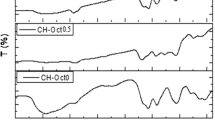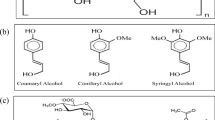Abstract
Marine oil spills and petrochemical discharges occurring either naturally or deliberately can have destructive impacts on environment and economy of a nation. Water bodies contaminated by oil pose challenge to the survival of aquatic biodiversity. Nanotechnology is offering new potential routes to remediate the oil pollution. In the present study, a superparamagnetic nanocomposite of Fe3O4/chitosan was synthesised using co-precipitation method. The prepared material was characterized to determine chemical structure, morphology, shape and size, thermal and magnetic properties. The magnetic adsorbent was employed for the adsorptive removal of petroleum based diesel oil from oil-in-water emulsions. The efficiency of the synthesized nanocomposite was examined by batch adsorption experiments to determine the effect of pH, adsorption time and adsorbent dose on the oil removal process. From the experimental data, it was found that the adsorption process followed the pseudo second order kinetics (R2 = 0.9962) and Langmuir isotherm (R2 = 0.9998) indicating towards a monolayer chemisorption process. Thermodynamic parameters showed that the adsorption was spontaneously endothermic (ΔH = + 38.779 kJ/mol) and the nanocomposite was found to be recyclable up to least five cycles of oil–water separation. The optimization of oil removal process was carried out using response surface methodology (RSM) as function of four factors consisting of pH, adsorbent dose, stirring speed and adsorption time. The study provides the basis for development of an eco-friendly and promising material for treatment of oil and hydrocarbon pollution from water bodies in environmental clean-up.







Similar content being viewed by others
References
Al-Ghouti MA, Al-Kaabi MA, Ashfaq MY, Da’na DA (2019) Produced water characteristics, treatment and reuse: a review. J Water Process Eng 28:222–239
X. Bi, R. Reed, P. Westerhoff (2015). Control of nanomaterials used in chemical mechanical polishing/planarization slurries during on-site industrial and municipal biological wastewater treatment. In: Frontiers of Nanoscience, vol. 8. Elsevier, Netherlands. pp 247–265
Foo KY, Hameed BH (2010) Insights into the modeling of adsorption isotherm systems. Chem Eng J 156(1):2–10
Gill SK, Singh G, Khatri M (2017) Synthesis and characterization of superparamagnetic iron oxide nanoparticles for water purification applications. 4(4):355–359
Ho YS (2006) Review of second-order models for adsorption systems. J Hazard Mater 136(3):681–689
Ivshina IB, Kuyukina MS, Krivoruchko AV, Elkin AA, Makarov SO, Cunningham CJ, Peshkur TA, Atlas RM, Philp JC (2015) Oil spill problems and sustainable response strategies through new technologies. Environ Sci Proc Imp 17(7):1201–1219
Jain A, Beg S, Saini S, Sharma T, Katare OP, Singh B (2019) Application of chemometric approach for QbD-enabled development and validation of an RP-HPLC method for estimation of methotrexate. J Liquid Chromatogr Relat Technol 42:1–11
Javid A, Ahmadian S, Saboury AA, Kalantar SM, Rezaei-Zarchi S (2013) Chitosan-coated superparamagnetic iron oxide nanoparticles for doxorubicin delivery: synthesis and anticancer effect against human ovarian cancer cells. Chem Biol Drug Des 82(3):296–306
Kalkan NA, Aksoy S, Aksoy EA, Hasirci N (2012) Preparation of chitosan-coated magnetite nanoparticles and application for immobilization of laccase. J Appl Pol Sci 123(2):707–716
Li P, Cai Q, Lin W, Chen B, Zhang B (2016) Offshore oil spill response practices and emerging challenges. Mar Pollut Bull 110(1):6–27
Lim J, Yeap SP, Che HX, Low SC (2013) Characterization of magnetic nanoparticle by dynamic light scattering. Nanoscale Res Lett 8(1):381
Lü T, Qi D, Zhang D, Lü Y, Zhao H (2018) A facile method for emulsified oil-water separation by using polyethylenimine-coated magnetic nanoparticles. J Nanoparticle Res 20(4):88
Mirshahghassemi S, Lead JR (2015) Oil recovery from water under environmentally relevant conditions using magnetic nanoparticles. Environ Sci Technol 49(19):11729–11736
Qiu H, Lv L, Pan BC, Zhang QJ, Zhang WM, Zhang QX (2009) Critical review in adsorption kinetic models. J Zhejiang Univ Sci A 10(5):716–724
Rohde P, Busch JA, Henkel RH, Voss D, Zielinski O (2009) Detection and identification of hydrocarbons in marine waters using time-resolved laser-fluorescence: set-up and first results of a new submersible sensor. Oceans 1–5
Ryder AG (2005) Analysis of crude petroleum oils using fluorescence spectroscopy. In: Geddes CD, Lakowicz JR (eds) Reviews in fluorescence. Springer, Boston, pp 169–198
Saha P, Chowdhury S (2011) Insight into adsorption thermodynamics. In: Tadashi M (ed) Thermodynamics, pp 349–364
Samrot AV, Shobana N, Sruthi PD, Sahithya CS (2018) Utilization of chitosan-coated superparamagnetic iron oxide nanoparticles for chromium removal. Appl Water Sci 8(7):192
Soares PI, Machado D, Laia C, Pereira LC, Coutinho JT, Ferreira IM, Nova CM, Borges JP (2016) Thermal and magnetic properties of chitosan-iron oxide nanoparticles. Carbohydr Polym 149:382–390
Unsoy G, Yalcin S, Khodadust R, Gunduz G, Gunduz U (2012) Synthesis optimization and characterization of chitosan-coated iron oxide nanoparticles produced for biomedical applications. J Nanoparticle Res 14(11):964
Wang H, Lin K, Jing B, Krylova G, Sigmon GE, Mcginn P, Zhu Y, Na C (2013) Removal of oil droplets from contaminated water using magnetic carbon nanotubes. Water Res 47:4198–4205
Yu L, Hao G, Gu J, Zhou S, Zhang N, Jiang W (2015) Fe3O4/PS magnetic nanoparticles: synthesis, characterization and their application as sorbents of oil from waste water. J Magn Magn Mater 394:14–21
Zhang B, Matchinski EJ, Chen B, Ye X, Jing L, Lee K (2019) Marine oil spills—oil pollution, sources and efects. In: Sheppard C (ed) World seas: an environmental evaluation. Academic Press, London. pp 391–406
Author information
Authors and Affiliations
Corresponding author
Electronic supplementary material
Below is the link to the electronic supplementary material.
Rights and permissions
About this article
Cite this article
Singh, H., Jain, A., Kaur, J. et al. Adsorptive removal of oil from water using SPIONs–chitosan nanocomposite: kinetics and process optimization. Appl Nanosci 10, 1281–1295 (2020). https://doi.org/10.1007/s13204-019-01195-y
Received:
Accepted:
Published:
Issue Date:
DOI: https://doi.org/10.1007/s13204-019-01195-y




